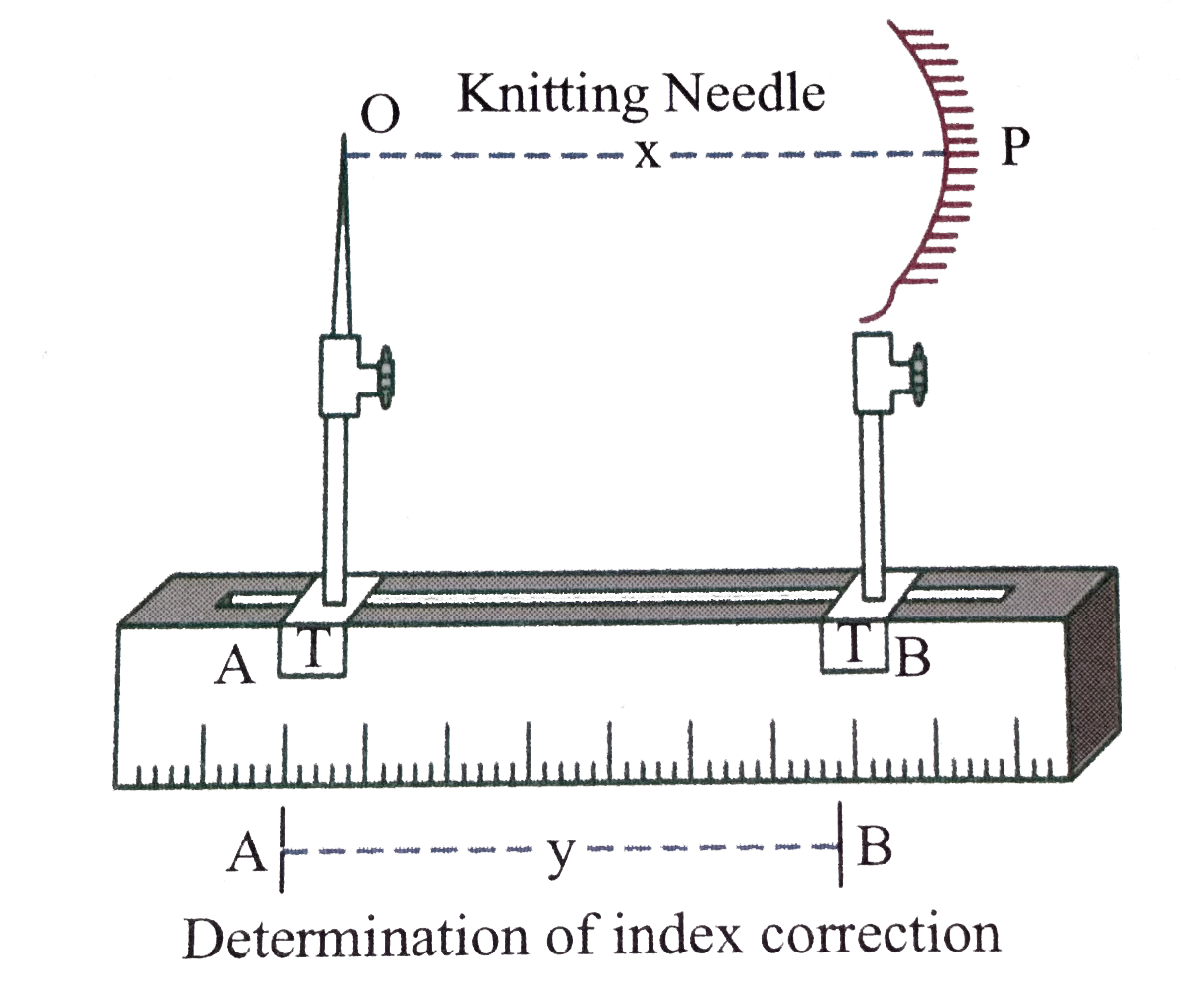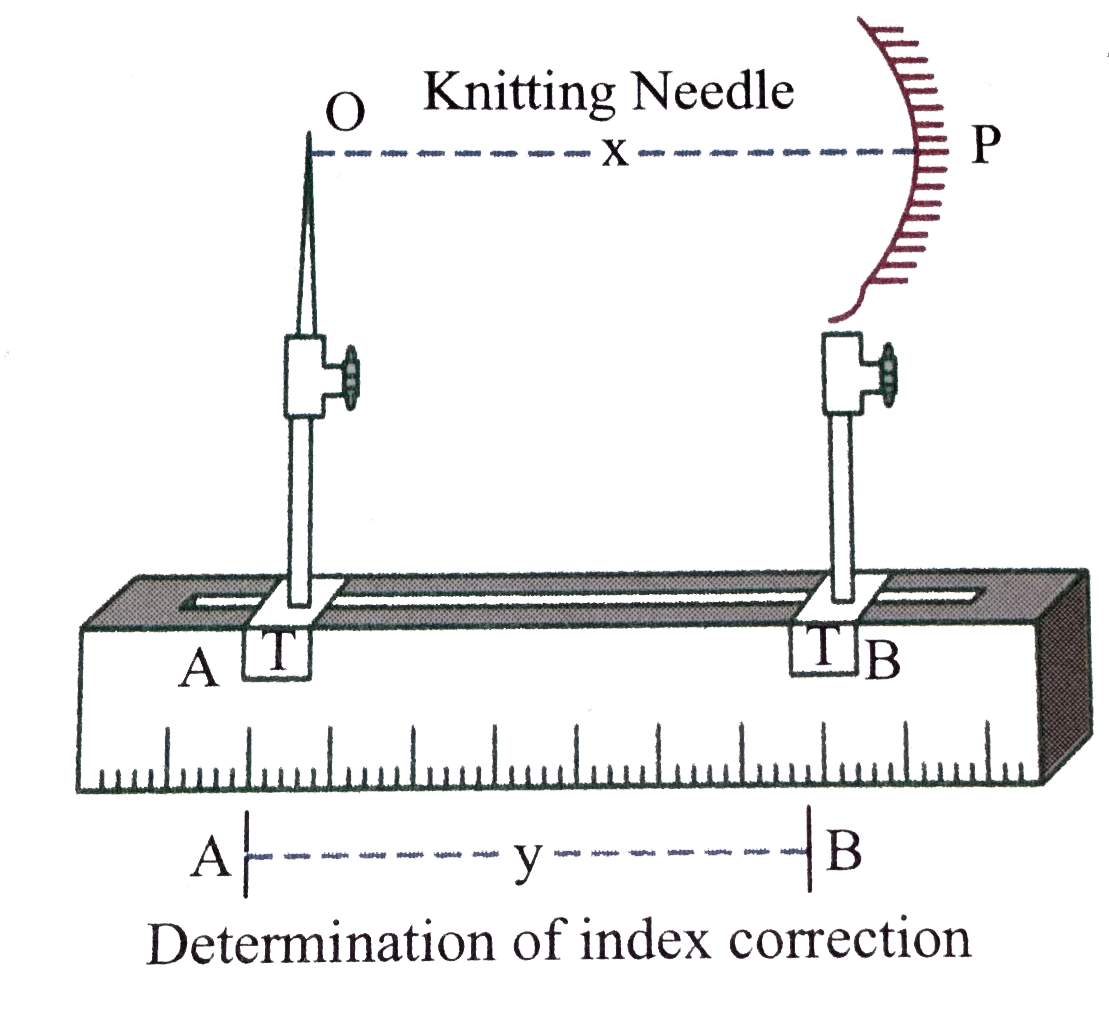To find index error for u when a knitting needle of length 20.0cm is adjusted between pole and object needle the separation between the indices of object needle and mirror was pbserved to be 20.2cm Index correction for u is .
−0.2cm
0.2cm
−0.1cm
0.1cm
Index error (Excess reading) = Obsorved reading Actual reading
=20.2−20.0=0.2cm .
Topper's Solved these Questions
- EXPERIMENTAL PHYSICSBook:RESONANCEChapter:EXPERIMENTAL PHYSICSExercise:Exercise
Explore 12 Videos
- EXPERIMENTAL PHYSICSBook:RESONANCEChapter:EXPERIMENTAL PHYSICSExercise:Exercise -1 PART
Explore 1 Video
- ELECTROSTATICSBook:RESONANCEChapter:ELECTROSTATICSExercise:HLP
Explore 39 Videos
- GEOMATRICAL OPTICS Book:RESONANCEChapter:GEOMATRICAL OPTICS Exercise:Advance level Problems
Explore 35 Videos
Similar Questions
To find index error e distance between object needle and poler of the concave mirror is 20cm. The separation between the indices of object needle and mirror was observed to be 20.2cm in some observation, the observed image distance is 20.2cm and the object distance is 30.2cm find
(a) the index error e.
(b) focal length of the mirror f.
View SolutionIn some observation the observed object distance (Separation between indicos of object needle and mirror) is 30.2cm and the observed imager distane is 19.9cm Using index correction from previous two questions estimate the focal length of the concave mirror .
View Solution
Knowledge Check
In u−v method, we require the distance between object or image from the pole (vertex) of the mirror (actual distance). But practically we measure the distance between the indices A and B. (Observed distance). Which need not exactly co-inside with object and pole, there can be a slight mismatch called index error, which will be constant for every observation.

Index error=Observed distance-Actual distance(Just like zero error in screw guage, it is the excess reading).
To determine index error, mirror and object needle and placed at arbitary position. For measuring actual distance, a knitting needle is just fitted between the pole of mirror and object needle O. The length of knitting needle will give the actual object distance while the seperation between indices A and B at that instant is the observed distance.
So index error is-
e=Observed distance-Actual distance
= Separation between indices A and B- Length of knitting neddle once we get e, in
every observation, we get
Actual distance=Observed distance (separation between the indices)- Excess reading(e) There is an another term, Index corraction which is invert of index error.
Index correction=-index error
To find index error for u, when a knitting needle of length 20.0cm is adjusted between pole and object needle, the sepertion between the indices of object needle and mirror was observed to be 20.2cm. Index corraction for u isA−0.2cmB0.2cmC−0.1cmD0.1cmTo find index error v when the same knitting needle is adjusted between the pole and the image needle the separation between the indices of image needle and mirror was found to be 19.9cm Index error for v is .
A0.1cmB−0.1cmC0.2cmD−0.2cmIn u−v method, we require the distance between object or image from the pole (vertex) of the mirror (actual distance). But practically we measure the distance between the indices A and B. (Observed distance). Which need not exactly co-inside with object and pole, there can be a slight mismatch called index error, which will be constant for every observation.

Index error=Observed distance-Actual distance(Just like zero error in screw guage, it is the excess reading).
To determine index error, mirror and object needle and placed at arbitary position. For measuring actual distance, a knitting needle is just fitted between the pole of mirror and object needle O. The length of knitting needle will give the actual object distance while the seperation between indices A and B at that instant is the observed distance.
So index error is-
e=Observed distance-Actual distance
= Separation between indices A and B- Length of knitting neddle once we get e, in
every observation, we get
Actual distance=Observed distance (separation between the indices)- Excess reading(e) There is an another term, Index corraction which is invert of index error.
Index correction=-index error
To find index error for v, when the same knitting needle is adjusted between the pole and the image needle, the separation between the indices of image needle and mirror was found to be 19.9cm. Index error for v isA0.1cmB−0.1cmC0.2cmD−0.2cm
In u−v method, we require the distance between object or image from the pole (vertex) of the mirror (actual distance). But practically we measure the distance between the indices A and B. (Observed distance). Which need not exactly co-inside with object and pole, there can be a slight mismatch called index error, which will be constant for every observation.

Index error=Observed distance-Actual distance(Just like zero error in screw guage, it is the excess reading).
To determine index error, mirror and object needle and placed at arbitary position. For measuring actual distance, a knitting needle is just fitted between the pole of mirror and object needle O. The length of knitting needle will give the actual object distance while the seperation between indices A and B at that instant is the observed distance.
So index error is-
e=Observed distance-Actual distance
= Separation between indices A and B- Length of knitting neddle once we get e, in
every observation, we get
Actual distance=Observed distance (separation between the indices)- Excess reading(e) There is an another term, Index corraction which is invert of index error.
Index correction=-index error
In some observation, the observed object distance (Separation between indices of object needle and mirror) is 30.2cm, and the observed image distance is 19.9cm. Using index correction from previous two equations, estimate the focal distance of the concave mirror!
View SolutionThe image formed by a convex mirror of focal length 20 cm is a quarter of the object. What is the distance of the object from the mirror?
View SolutionIn a given optical bench, a needle of length 10 cm is used in between (object & lens) and lens and image to estimate bench error. The object needle, image needle & lens holder have their reading as shown.
X0=1.1cm,Xi=21.0cm,XL=10.9cm
Estimate the bench errors which are present in image needle holder and object needle holder. Also find the focal length of the convex lens when it is given that
X0=0.6cm,Xi=22.5cm XL=11.4cm
View SolutionThe magnifying power of a telescope is 9. When it is adjusted for parallel rays the distance between the objective and eyepiece is 20cm. The focal lengths of lenses are
View SolutionA concave mirror has a focal length 20 cm. The distance between the two positions of the object for which the image size is double of the object size is
View Solution

